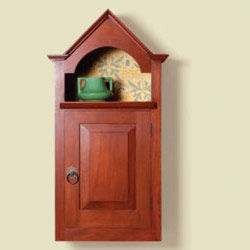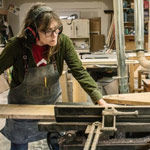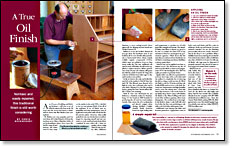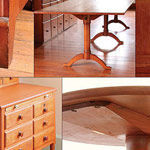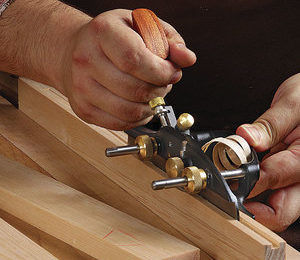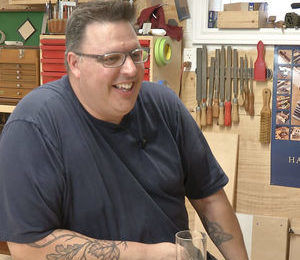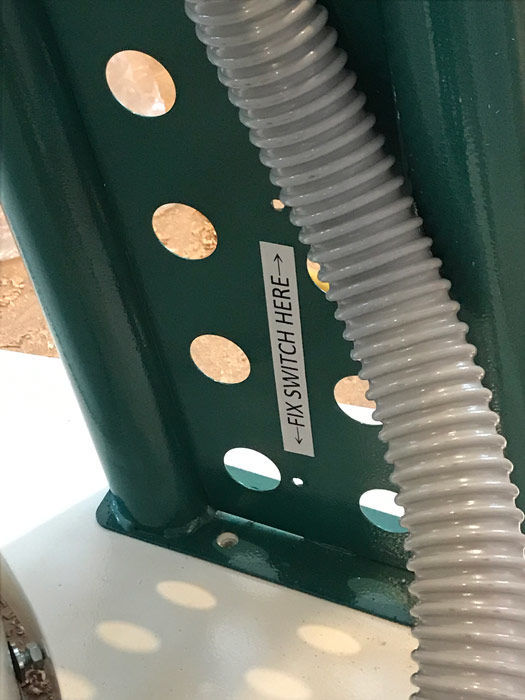Fri, 10 May 2019
Guest 1: Joe Taylor - Director of Sales for Rikon Joe gave us the ins and outs of a few of Rikon's new products Model 10-326DVR: 14″ Deluxe Bandsaw with Smart Motor DVR Control
Guest 2: Nancy Hiller From Jim: In terms of their aesthetic value, is there a line for you between fine furniture and cabinetry? From Jeff: If you could only design, or build, which would it be and why?
Guest 3: Christian Becksvoort From Scott: What are your top five records at the moment? From Josh: What Shaker element do see reproduced poorly in modern versions of the classics? From Erick: What finish are you using on most of your pieces, polyurethane or oil? And why?
Guest 4: Vic Tesolin From Kevin: What aspects of woodworking do you see most newer students totally over think? From Steve: Awhile ago, you posted a video of a tattoo that had leaves representing your favorite woods to work with. For those of us who are crap at identifying tree leaves, what are your favorite woods to build with?
Every two weeks, a team of Fine Woodworking staffers answers questions from readers on Shop Talk Live, Fine Woodworking‘s biweekly podcast. Send your woodworking questions to shoptalk@taunton.com for consideration in the regular broadcast! Our continued existence relies upon listener support. So if you enjoy the show, be sure to leave us a five-star rating and maybe even a nice comment on our iTunes page. |
||||||||||||
Fri, 26 April 2019
Question 1: From Al: I am having some trouble laying out the pins and tales on the Wenge in the more traditional way, unlike what Mike shows. Wenge is extremely hard and not at all forgiving and the grain tends to be a problem in scribing the wood. Perhaps this is why he choose to do this with the table saw and router methods as shown on Rough Cut. Where can I get the table saw blade and the router bit to do it like Mike. He always has great ideas that are very valuable.
Question 2: From Madison: I was wondering how long it took Mike to build the tea box featured in magazine issue 269. Segment: Ben: Steam bending everything! Question 3: From Matt: How would someone go about preparing kumiko strips without a tablesaw or drum sander? Every two weeks, a team of Fine Woodworking staffers answers questions from readers on Shop Talk Live, Fine Woodworking‘s biweekly podcast. Send your woodworking questions to shoptalk@taunton.com for consideration in the regular broadcast! Our continued existence relies upon listener support. So if you enjoy the show, be sure to leave us a five-star rating and maybe even a nice comment on our iTunes page. |
||||||||||||
Fri, 12 April 2019
Question 1: From Paul: Heide Martin’s serving trays in the May/June 2018 are beautiful and I have since made a couple. My question is about keeping the bottom boards flat. I cut some walnut that had been air dried for probably 20 years. In an hour or two both boards cupped. I then sequentially tried wetting one side, wetting both sides, soaking in water, soaking in fabric softener, each time clamping the boards to keep them flat and leaving for days and days to dry out. None of these things worked and in the end I ended up using some walnut plywood instead. How do you folks keep wide, thin boards flat?
Question 2: From Richard: In reality we all have limited amount of shop time available. However, if the amount of time you could work on a project was not limited what one piece would you choose to make?
Segment: All-Time Favorite Technique Mike: Using pocket holes to quickly make and change full-size mockups Tom: Beveling an edge of a workpiece with a handplane Ben: Riding the back of the blade to start a cut on the edge of workpiece Question 3: From Mark: I have been building furniture full-time for just over a year. Is it legal and/or ethical to build something from the magazine or a video workshop and then sell it? For instance, if a client asks me to build 4 Adirondack chairs, my thought is build them loosely based on what I find at Fine Woodworking, vs. reinventing the wheel with my own design every-time. Question 4: From John: I was reading a FWW article by Steve Latta in issue #241 about draw-bored tenons where he said, “I make pins from riftsawn or quartersawn stock...”. If you’re making dowels, how can it possibly make any difference whatsoever if you use quartersawn or plain sawn boards? I still like Steve Latta, btw. Keep up the great work, see y’all at FWWlive! Every two weeks, a team of Fine Woodworking staffers answers questions from readers on Shop Talk Live, Fine Woodworking‘s biweekly podcast. Send your woodworking questions to shoptalk@taunton.com for consideration in the regular broadcast! Our continued existence relies upon listener support. So if you enjoy the show, be sure to leave us a five-star rating and maybe even a nice comment on our iTunes page. |
||||||||||||
Fri, 29 March 2019
Question 1: From Harry: How can I prevent Camellia from becoming all gummy. After letting a plane set for a few weeks that had been wiped down with Camellia Oil it was next to impossible to get the plane apart. I actually caused some minor damage it was stuck so hard. Rollie’s answer: On tools if you have areas that the oil is applied to that don’t see use it can build a bit, but not much and over a long period of time. A quick wipe with a bit of naphtha or acetone will clean it off. Those solvents are essential because they are fully volatile and won’t leave any oily residue, which mineral spirits will do. Question 2: From Mike: In in a couple months I will be building a house and I will be putting my shop in the basement. Currently I have a small shop, but in my new shop it will be large (about 25x35). Since I have this rare opportunity, I want to put power in the floor and dust collection the floor. Therefore, I have to decide where to put my tools and I will not be able to move them. Are there general guidelines on placement of tools? How far should a table saw be away from a wall? What about a bandsaw, how far from a wall or in the sides? Same question for a router table, jointer and thickness planer.
Segment: All-Time Favorite Technique Mike: Using a bendy stick to hold in moldings as you glue them Anissa: A Box Worth Repeating by Laura Mays #240–May/June 2014 Issue Ben: Using blue tape and CA glue as a stand-in for double-sided tape Mike’s double-down technique: Using a bendy ruler clamped in a pipe clamp as a curve bow Question 3: From Chris: Question 4: From Jim: Recommendations: Ben - StewMac’s YouTube Channel Every two weeks, a team of Fine Woodworking staffers answers questions from readers on Shop Talk Live, Fine Woodworking‘s biweekly podcast. Send your woodworking questions to shoptalk@taunton.com for consideration in the regular broadcast! Our continued existence relies upon listener support. So if you enjoy the show, be sure to leave us a five-star rating and maybe even a nice comment on our iTunes page. |
||||||||||||
Fri, 15 March 2019
Question 1: From Shawn: I’m working on a Christmas present for my sister. It’s a hallway table with 2 drawers in cherry. This is the first piece I’ve made with cherry. Some of the surfaces have a quarter sawn grain orientation and I’m finding them highly prone to tear out. My card scraper seems to be the only tool I’ve got that can tackle it, and even then I still have to pay really close attention to the changing grain direction. I’d like to hear any recommendations you might have about tools and techniques to deal with tear out, and also about other tear out prone woods you’ve worked with. I’ve found quarter sawn maple to be difficult as well.
Question 2: From Joe: To build a bed for my grandson I ordered 50 bd ft of rough lumber, Black walnut. The wood was beautiful but this is where my confusion began. I got the job done but I don't know if I went about it the best way. The bed with headboard, frame, 6 drawers underneath, and footboard had over 100 pieces. All the lumber was about 8 inches wide and about 10 feet long. Is it better to mill the long boards and then layout all the parts, or layout the parts oversize and cut them out and send smaller pieces through the planer and jointer? Segment: All-Time Favorite Tool Mike: 6-in. Combo Square Question 3: From Mike: I’ve come to realize my jointer needs tuning, and i recall you guys saying how you set your outfeed table a hair lower than your cutter head. I can’t find the episode that contains this discussion, but i don’t recall there being any reasoning for this. I adjusted mine as y’all suggested but found this was causing the trailing ends of the boards to not touch the blades. After reading my powermatic manual, it says to have the outfeed table level with blade, so what’s up with your hack causing me this grief? Recommendations:
Every two weeks, a team of Fine Woodworking staffers answers questions from readers on Shop Talk Live, Fine Woodworking‘s biweekly podcast. Send your woodworking questions to shoptalk@taunton.com for consideration in the regular broadcast! Our continued existence relies upon listener support. So if you enjoy the show, be sure to leave us a five-star rating and maybe even a nice comment on our iTunes page. |
||||||||||||
Fri, 8 March 2019
Chris Schwarz is a furniture maker and writer who works from a German barroom built in 1896 in Covington, Ky. He is one of the founders of Lost Art Press, a book-publishing company that specializes in handwork, and Crucible Tool, a company that makes hand tools for woodwork. Chris is the author of several books, including Workbenches: From Design & Theory to Construction & Use (F+W Media), The Anarchist’s Tool Chest, Campaign Furniture, The Anarchist’s Design Book and Ingenious Mechanics (Lost Art Press). In addition to his publishing efforts, he builds casework and Welsh stick chairs for clients all over the world. Chris' class at Fine Woodworking Live is titled: Compound-Angle Joinery, Minus the Math Register now for Fine Woodworking Live 2019! Enter for your chance to win Fine Woodworking's Shop Giveaway: Upgrade to Laguna! The winner will receive a prize that includes:
|
||||||||||||
Fri, 1 March 2019
Enter for your chance to win Fine Woodworking's Shop Giveaway: Upgrade to Laguna! The winner will receive a prize that includes:
Question 1: From William: I live in Ohio where the Emerald Ash Borer is ravaging every ash tree around. With all these ash trees coming down and the infestation of the Ash Borer, are we looking at a future shortage of ash trees? Should we, as woodworkers, stock up on quality ash boards while we can get them and while they're fairly inexpensive? Question 2: From Paul: I’ve started looking for a better sketchbook and am overwhelmed by the choices. I’ve heard Mike talk about the books he uses, but I’ve never heard him mention the brand or “model” he favors. On STL 155 he mentioned 60-80 lb paper, spiral bound, unruled, 6x9 size. Frankly, that limits it to about half a zillion options and it’s very hard to judge quality even touching the book at the local art supply place. So please spill, Mike! Segment: All-Time Favorite Tool
Question 3: From Caleb: I'm wondering if any of you have used a hollow chisel mortiser as a drill press? Is this a viable way to get around buying a drill press? Question 4: From Chris: What books inspire you to get out to your shop and build something? Any favorite books on the history of woodworking and maybe different trends through the ages? Or books specific to a style of working, like Shaker or arts & crafts, etc.? And from Larry: I would love to see a Live Talk episode on “go to books” reference books for novice woodworkers. Every two weeks, a team of Fine Woodworking staffers answers questions from readers on Shop Talk Live, Fine Woodworking‘s biweekly podcast. Send your woodworking questions to shoptalk@taunton.com for consideration in the regular broadcast! Our continued existence relies upon listener support. So if you enjoy the show, be sure to leave us a five-star rating and maybe even a nice comment on our iTunes page. |
||||||||||||
Fri, 15 February 2019
Leave a comment on this episodes show notes page to be entered in the giveaway of Craig Thibodeau's book, The Craft of Veneering. Peter Galbert’s FWW Live 2018 Keynote Speech - Unsurprisingly, the journey of a windsor chairmaker is rarely a straight line
Question 1: From David: I have avoided cordless power tools because as a hobbyist and renter, I seldom use the tools outside of the basement workshop. I've been told I don't know what I'm missing, but it seems my wallet prefers it that way. I'm most concerned about trying to commit to one brand/manufacturer or contend with the expense and hassle of having multiple chargers and batteries that aren't compatible. Do you feel as though it makes sense to keep all of your cordless power tools within the same brand? Or is my concern unfounded? If you had to commit to a brand, what would they be and why? Question 2: From Harry: How can I prevent Camellia from becoming all gummy. After letting a plane set for a few weeks that had been wiped down with Camellia Oil it was next to impossible to get the plane apart. I actually caused some minor damage it was stuck so hard. Segment: Smooth Move Ben: Not looking at the fine print on a router bearing
Question 3: From J: Hey folks, I recently volunteered to be the shop manager for my local guild of woodworkers. We have a 16” Oliver that apparently, according to some, must never have its bed waxed. They prefer it is cleaned only with kerosene, the reason being that it’s believed waxing a jointer bed will cause glue joints to fail. Any merit to this train of thought? Or can I just wax it and make everyone’s lives easier. Question 4: From Joe: I’ve gotten very good at sharpening my hand plane blades as well as making my wood surface feel silky smooth off the hand plane. When using a 2 pound cut shellac as a finish, do I need to rough up wood surface with sandpaper (such as 300 grit) so the shellac can stick better to the wood surface? Every two weeks, a team of Fine Woodworking staffers answers questions from readers on Shop Talk Live, Fine Woodworking‘s biweekly podcast. Send your woodworking questions to shoptalk@taunton.com for consideration in the regular broadcast! Our continued existence relies upon listener support. So if you enjoy the show, be sure to leave us a five-star rating and maybe even a nice comment on our iTunes page. |
||||||||||||
Fri, 8 February 2019
Normally here I post a bunch of links. I'm going to be honest, you just need one link on this, Craig's website. Everything he discusses is easily found on his website, and the site itself is wonderfully done. It's worth going to just to see how a real pro presents their work. Plus, while you're there you can buy a signed copy of his book! -Ben https://ctfinefurniture.com/ |
||||||||||||
Fri, 1 February 2019
How Ben finished Mike's spoon - Finish Greenwood Spoons Like a Pro by Emmet Van Driesche Question 1: From Fabian: I have a sliding table saw and struggle to convert all the jigs mentioned in the magazine to fit my saw. How would you attach for example a kumiko grid jig as used by Mike in the article "Spice up your work with kumiko" to the saw? Do I fasten it with bolts to the crosscut fence or just let it ride in the one miter slot in the sliding table? In either case it is just secured on the left side of the blade.
Question 2: From Chris: I'm on the lookout for a new paste wax solution. I'm totally over the petroleum smell of commercial options, and would love something simple with just a bit of luster to apply to my projects. Has Mike ever shared his recipe to attempt to recreate the non-longer-available Goddard's Cabinet Makers Wax? I never used the product in its original form, but I'm sold on his description of it. Something natural, simple, and lemon-scented sounds like the perfect solution for me.
Segment: All Time Favorite Tool of All Time… for this week Tom: Cabinet scraper and card scraper Question 3: From Josh: I see pictures posted online where people have gotten a completely mirror polished edge on a chisel or plane iron. I’m using a Norton 1000 water stone, followed by a King 3000, followed by a Norton 8000 stone. I can’t seem to get that mirror polish. I still end up with some scratches, no matter how long I work with the 8000 stone, even when honing a new blade. I know Mike recommends 1000/4000/8000, but Lie Nielsen skips the intermediate grit, so I don’t think the 3000 stone is my problem. I’ve thought about trying to get a finer stone than the 8000 I have, but I don’t want a $100 experiment. Question 4: From Peter: The cement floor of my shop is unsealed and kind of wrecks my feet after a day in the shop. Keeping in mind that it’s a rental, do you have any recommendations for an affordable flooring option that may help my feet and also protect my equipment from the sludge that melts off my wife’s car? It needs to be solid enough that I can have my lathe on that won’t increase vibration. Every two weeks, a team of Fine Woodworking staffers answers questions from readers on Shop Talk Live, Fine Woodworking‘s biweekly podcast. Send your woodworking questions to shoptalk@taunton.com for consideration in the regular broadcast! Our continued existence relies upon listener support. So if you enjoy the show, be sure to leave us a five-star rating and maybe even a nice comment on our iTunes page. |
||||||||||||
Shop Talk Live - Fine Woodworking

Categories
generalArchives
AprilMarch
February
January
December
November
October
September
August
July
June
May
April
March
February
January
December
November
October
September
August
July
June
May
April
March
February
January
December
November
October
September
August
July
June
May
April
March
February
January
December
November
October
September
August
July
June
May
April
March
February
January
December
November
October
September
August
July
June
May
April
March
February
January
December
November
October
September
August
July
June
May
April
March
February
January
December
November
October
September
August
July
June
May
April
March
February
January
December
November
October
September
August
July
June
May
April
March
February
January
December
November
October
September
August
July
June
May
April
March
February
January
December
November
October
September
August
July
June
May
April
March
February
January
December
November
October
September
August
July
June
May
April
March
February
January
December
November
October
September
August
July
June
May
April
March
| S | M | T | W | T | F | S |
|---|---|---|---|---|---|---|
| 1 | 2 | 3 | 4 | 5 | 6 | |
| 7 | 8 | 9 | 10 | 11 | 12 | 13 |
| 14 | 15 | 16 | 17 | 18 | 19 | 20 |
| 21 | 22 | 23 | 24 | 25 | 26 | 27 |
| 28 | 29 | 30 | ||||
Syndication

